The 2013 NISSAN PATHFINDER
The 2013 Nissan Pathfinder is the fourth generation design of this iconic Sport Utility Vehicle. Nissan redesigned the "family-hauler" to better support today's urban and suburban family's needs. The new Pathfinder has been given enhanced comfort, innovative/ advanced technology, and increased fuel efficiency, without giving up its SUV off-road prowess. For 2013 the Pathfinder is powered by a refined 3.5L VQ-family V6 engine: 260 hp @ 6,400 rpm and 240 lb-ft of torque @ 4,400 rpm. The new VQ35DE is mated to the next-generation Xtronic CVT®, resulting in this power train achieving a 25% increase of fuel economy over the previous V6 with its traditional multi-gear transmission. The new engine and CVT combination offers improved efficiency, while maintaining nearly the same horsepower as the previous generation's larger displacement V6.
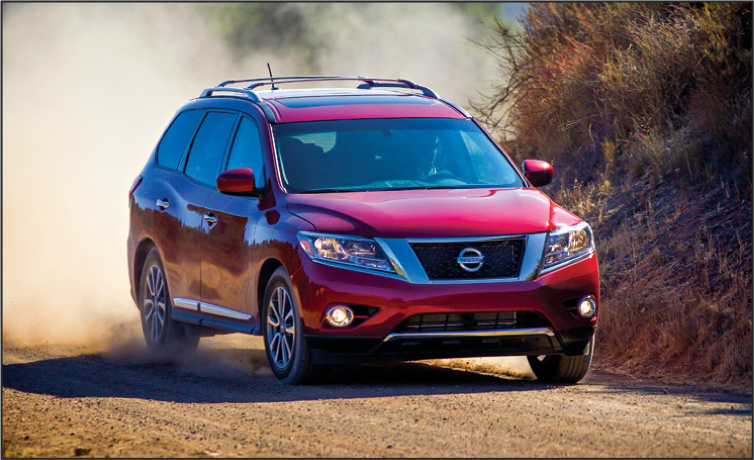
One of the biggest design changes for the 2013 model was to take the body-on-frame SUV Pathfinder and base it on a D platform returning to a unibody construction (like what is used for the Infiniti JX35 and the new 2013 Altima). The unibody construction helped increase Pathfinder's structural rigidity over the previous models. This design also offers the benefit of a flat floor for enhanced flexible interior packaging. The 2013 Pathfinder has been given an unprecedented level of premium style, comfort and class-exclusive thoughtful technology – including a dramatic new aerodynamic exterior design. Some of the new exterior design details are the front and rear spoilers, rear tire deflectors and rear suspension fairings. A wide chrome grille and large aerodynamic headlights, recessed front windshield wipers, chrome door handles and large rear combination lights have also been added. The new Pathfinder has a panoramic dual-panel moonroof, with a sliding opening front panel and fixed rear glass panel equipped with power sunshade which extends over the 2nd and 3rd rows. Even with all these changes the next-generation Pathfinder weighs significantly less than the outgoing truck-based-frame model which helps contribute to better fuel economy. The new design sheds 500-pounds compared to the 2012 Pathfinder. It's now one of the lightest vehicles in its segment.
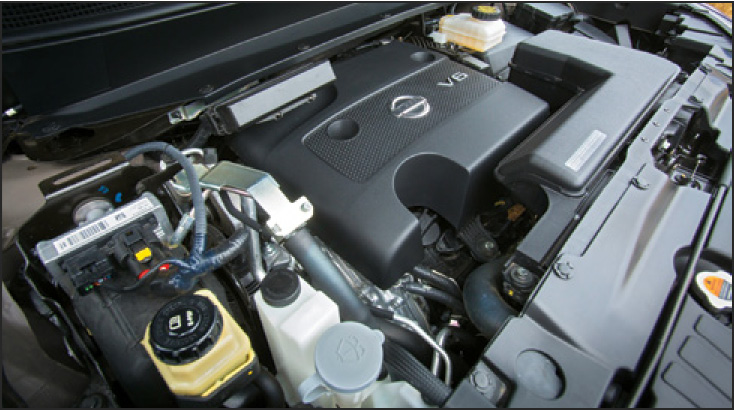
Continuously Variable Transmission
The new Pathfinder achieves fuel efficiency improvements over the previous model with the help of a next-generation Xtronic CVT®. This new responsive electronically controlled transmission was designed to reduce driveline friction and produce maximum power with a smooth expanded ratio range coverage. The RE0F10E uses a high-strength steel chain rather than a belt. It's still steel, but has a unique design to support the power and towing capacity of the Pathfinder. It operates between two continuously adjustable pulleys allowing the engine to operate in the optimum power range seamlessly for a variety of driving conditions. The groove width changes according to wrapping radius of chain belt and pulley from low range to overdrive range continuously with "no steps." The pulleys are controlled to expand and contract which enables the drive diameters to be varied for an infinitely variable drive ratio. The CVT Control system is capable of selecting a ratio for most every driving situation, continuously changing the ratio or holding the ratio position with Adaptive Shift Control (ASC). The CVT control system detects the vehicle driving status based on the signals from the sensors, switches, and other control units to perform optimal transaxle control. This information is output to the primary reducing valve and secondary reducing valve to control the line pressure input/output to pulley, determining the movable pulley position. The ASC selects the optimum ratio based on the specific condition by coordinating engine speed (RPM) with vehicle speed as the vehicle accelerates. The new Xtronic CVT uses lower viscosity Genuine Nissan NS-3 CVT fluid, and was designed with a vane-type oil pump. The oil pump is driven by the engine through the oil pump drive chain. This increases efficiency of pump discharge volume in low-speeds, and optimizes pump discharge volume at high-speed speeds.
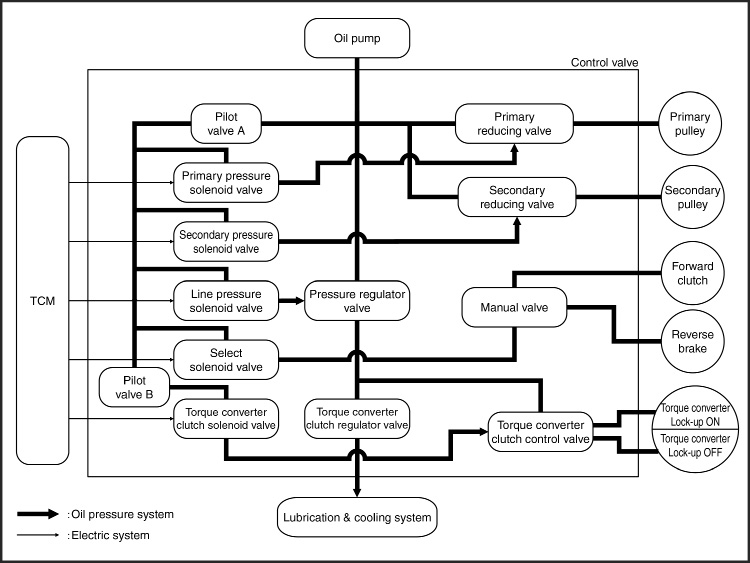
CVT Fluid Cooler
The 2013 Pathfinder is equipped with an external CVT fluid cool er that's installed to the front LH of the vehicle behind the left front fog light. It helps to prevent the CVT fluid from an abnormal increase of temperature by cooling i t with air flowing through the radiator style cooler while the vehicle is being driven.
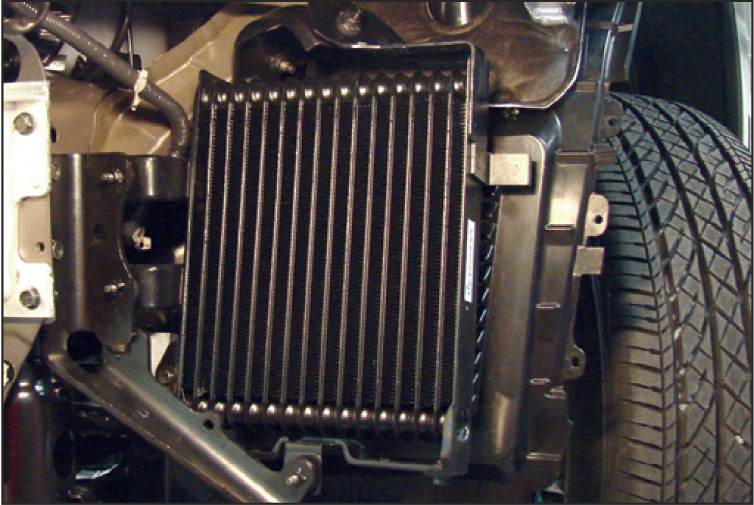
Intuitive ALL-MODE 4x4-i system
The Intuitive Auto Mode system featured in the 2013 Nissan Pathfinder is so advanced it can detect traction needs and reacts accordingly to most any driving condition the customer's likely to encounter. The 4WD Mode Switch allows the driver to select 2WD (Two-Wheel Drive), AUTO or Four-Wheel Drive (4WD) LOCK mode depending on the driving conditions. "Intuitive" Auto Mode constantly monitors road conditions and automatically shifts from All-Wheel Drive to rear-wheel drive to deliver performance and stability that adapts to driving conditions. The system can automatically sense slippery conditions or bumpy terrain by constantly monitoring wheel spin, throttle position and vehicle speed. The system then automatically diverts up to 50% of the available power to the front from the rear wheels, helping enhance traction and control when conditions are less than optimal. When driving conditions smooth out and all-wheel drive is not needed, the system sends 100% of the power to 2WD mode which is recommended for driving on dry pavement in good conditions. Auto Mode is suitable for most driving conditions and will vary power to the rear wheels as needed. Lock mode is recommended for road or weather conditions that require the most traction from all four wheels. If the vehicle is continuously operated under conditions where there's a large amount of traction difference between the front and rear wheels producing wheel slip: such as when driving the vehicle on rough roads through sand or mud, or when freeing a stuck vehicle; the 4WD warning light will blink rapidly and the 4WD mode changes to the 2WD mode to protect the power train parts.
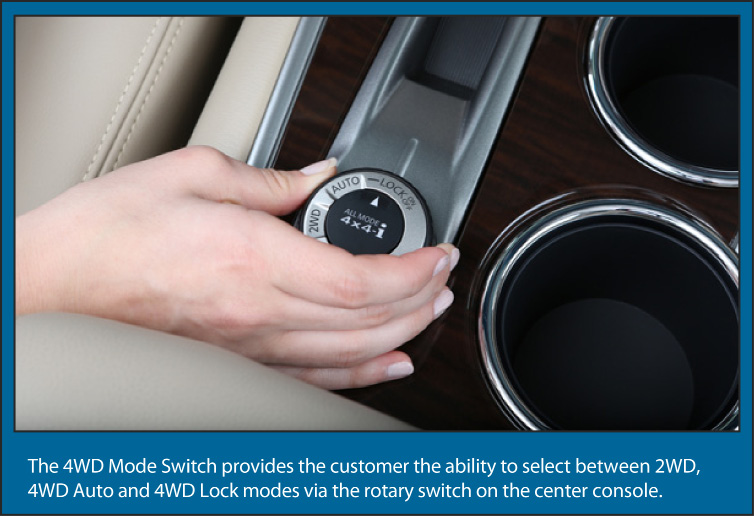
Suspension
The Nissan Pathfinder has an independent strut front and multi-link rear suspension that includes front and rear stabilizer bars.
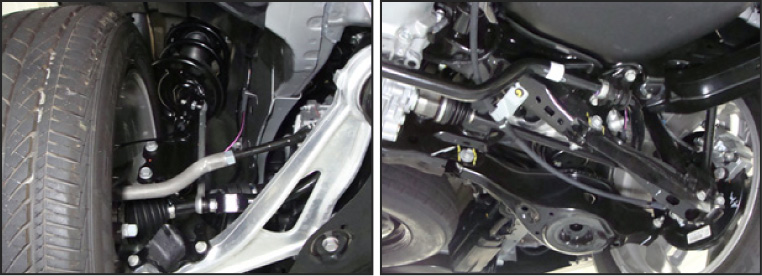
Steering
Electronic Hydraulic Power-assisted Speed-sensitive Steering
The new Pathfinder utilizes a Hydraulic Electric Power Steering (HEPS) system. The system is smaller than traditional power steering systems, which was achieved by integrating multiple parts. The primary components of this system are: PS Oil Pump Assembly (which includes the PS C/U, PS motor, power steering oil pump, and reservoir tank). Other components are the Steering Angle Sensor, Engine Control Module, Combination Meter, Steering Gear Assembly, and Torque Sensor. Power to the hydraulic pump of the electro-hydraulic power steering system is delivered by an electric motor and not the engine directly. This means engine load does not change when speed increases, because power is being delivered by the battery and electric motor. With the HEPS the electric motor operation is controlled by the Engine Control Module via CAN communication for precise monitoring of steering force, vehicle speed and steering angle.
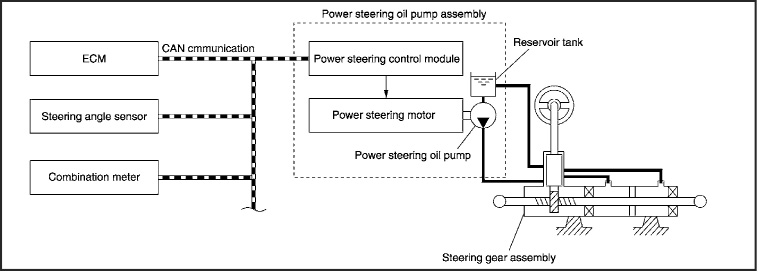
The hydraulic electric oil pump operates when the engine starts. The ECM controls the hydraulic pressure transmitted from the power steering motor to power steering oil pump, based on the input it receives from the steering angle sensor and combination meter. When the steering angle speed is low or the vehicle speed is high, the system lowers the hydraulic pressure and reduces the steering assist force. Higher hydraulic pressure is applied when the vehicle speed is low or when the steering operation angle speed is high. The system raises the hydraulic pressure, which increases the steering assist force.
Important HEPS Function Information
- If the steering wheel is operated repeatedly or turned all the way continuously while parking or driving at a very low speed, the function of the hydraulic pump electric power assist steering system will become limited to help prevent the system from overheating.
If a customer continues to perform steering wheel operation while the power assist is reduced, the hydraulic pump electric power steering system may stop. This is not a malfunction. While the power assist is reduced, steering wheel operation will become temporarily heavy in a manual state, and the hydraulic pump electric power steering warning light will illuminate to warn that the system is in the manual state. Turning the engine OFF for a while will allow the temperature of the hydraulic pump electric power steering system to lower and allow the power assist level to return to normal. When the engine is started again, the hydraulic pump electric power steering warning light will go off. DTC C160A Heat Protection will be set and remain until erased to distinguish that the system temporarily entered into the manual steering state.
Note: With a conventional-type steering assist, the steering pump is powered by the engine. Operational noise increases and is masked as engine speed increases. However, on vehicles equipped with the Hydraulic Pump Electric Power Steering system, normal operation noise increases and may be heard above engine noise from the engine compartment when vehicle speed is low and steering operation angle is high. The noise is heard because in order to provide the required steering assist force at lower engine RPM the rotating speed of the hydraulic electric pump increases.
By providing power assist via hydraulic electric pump pressure, this system delivers a naturally smooth steering feel due to the flexibility of control allowed by electric power. This system allows more precise steering power characteristics. It also improves fuel economy since the electric powered pump operates only when steering assist is needed.
Note: The HEPS requires the use of Genuine NISSAN E-PSF. If another power steering fluid is used, it will prevent the power steering system from working properly and may seriously deteriorate the system's ability to produce steering assist force. Always check the fluid while the engine is stopped.
Interior
The new Pathfinder has a roomy interior that features three rows of seats that provides accommodations for seven passengers. There are a remarkable amount of different seating configurations made possible with the innovative EZ Flex Seating System™. The EZ Flex Seating System™ allows extra second row seat travel making it easy to adjust legroom or accommodate cargo spontaneously as needed.
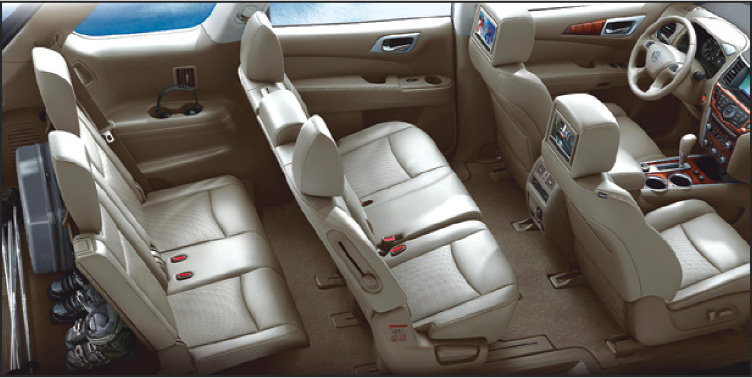
The second-row seats feature a 60/40 split, manual slide/recline/fold flat functionality. The 2nd row has a Latch and Glide™ function which allows you to tilt and slide the right-side 2nd-row seat even with a child seat still installed. The 2nd-row seats feature 5.5 inches of travel for increased legroom or cargo capacity (with the 50/50 split, reclining third row folded). The 2nd-row seat forward folding seat design along with larger rear door openings to aide access to the third-row. Since both the second and third rows fold flat the Pathfinder can handle large items providing up to 78.9 cubic feet of cargo space.
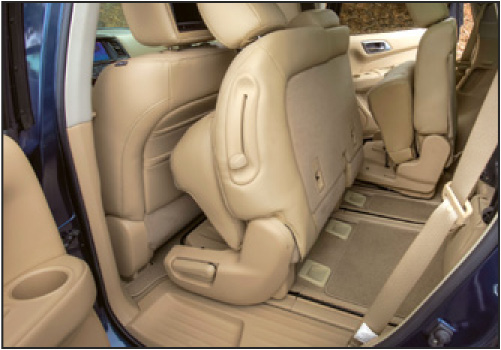
The Pathfinder SL and Platinum trims come standard with leather-appointed seats and are available with heated and cooled front seats (Platinum only), and heated second-row outboard seats. There is a Thermal Electric Device (TED) installed in the seat cushion and seatback of the front seats. The TED is a heat exchanger that has a function to heat or cool the airflow from the climate controlled seat blower motor. By changing the direction of the current from the power supply, the TED takes or gives heat, and adjusts the heat exchange process depending on voltage.
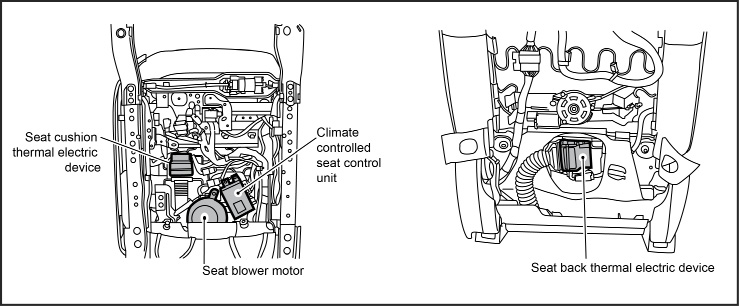
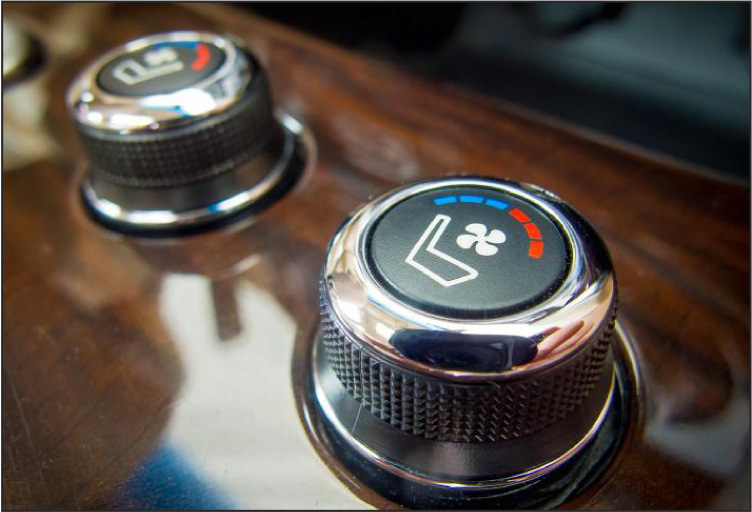
Heated steering wheel
The heated steering wheel system is designed to operate only when the surface temperature of the steering wheel is below approximately 68°F (20°C).
If the surface temperature of the steering wheel is below 68°F (20°C), the system will heat the steering wheel to approximately 86°F (30°C), then turn OFF automatically.
Note: The heated steering wheel switch is equipped with a 30 minute t imer. After the switch has been activated for 30 minutes, the system will automatically turn OFF. If the surface temperature of the steering wheel is above 68°F (20°C) when the switch is turned ON, the system will not heat the stee ring wheel. This is not a malfunction.
The heated steering wheel is activated by the power supply from the heated steering wheel relay through the A/C Auto amp.
Heat is generated by the passage of an electric current through a heating element and a thermostat that controls the ON/OFF operation of power su pply at certain steering wheel temperatures.
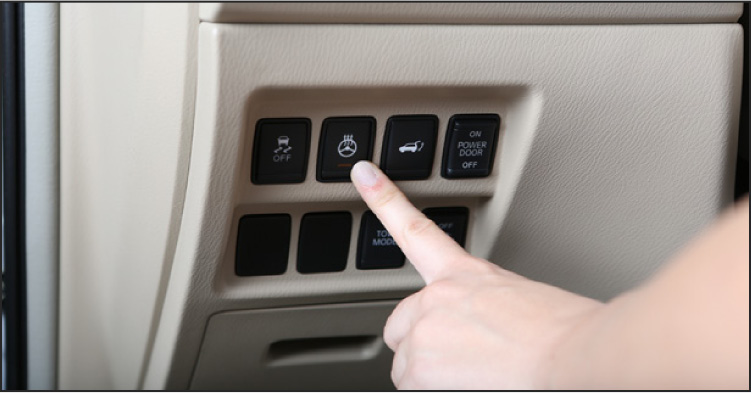
Advanced Drive-Assist™
The 2013 Nissan Pathfinder comes with a new Advanced Drive-Assist™ Display, located in the center of the instrument display between the tachometer and speedometer, features a 4-inch color LCD screen that is customizable, easy-to-use and integrates key information right in front of the driver. This innovative new system is designed to help help minimize time spent looking away.
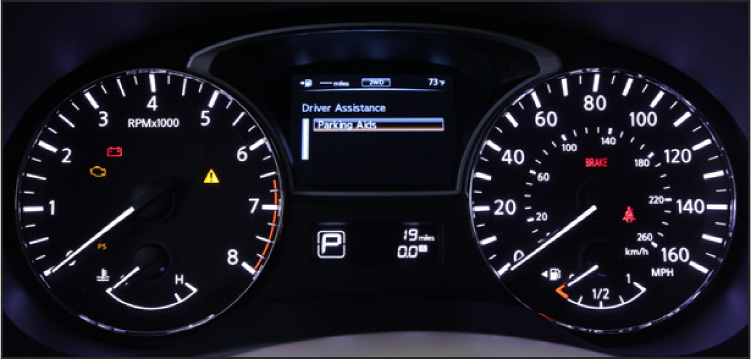
The Advanced Drive-Assist™ Display allows the driver to access information such as the status of cruise control system information, NISSAN Intelligent Key® operation information, trip computer information, individual tire pressure, fuel economy, and more via controls on the steering wheel.
The Parking Aid cannot be turned OFF with the dash switch. The Parking Aids can be enabled or disabled by using the Settings screen.
Main Menu Selection
The customer can customize the display by selecting the screens that show the information they use most often.
- Trip Computer
- Audio
- Navigation (if equipped)
- Tire Pressures (if equipped)
- Fuel Economy
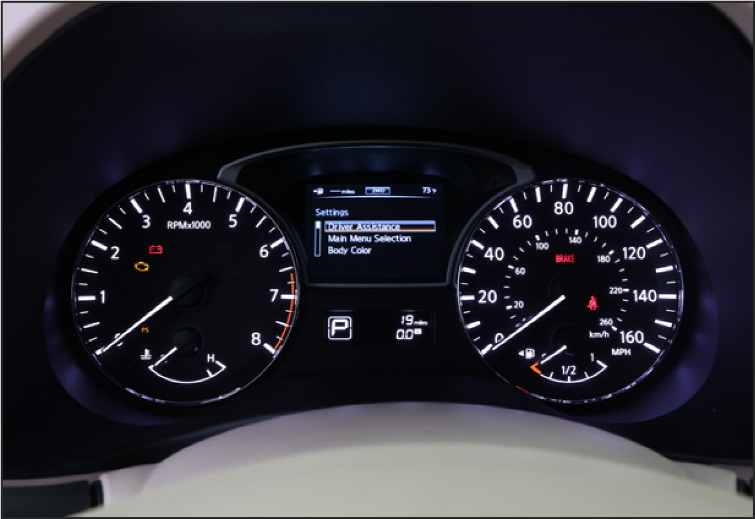
Remote Start Intelligent Keys
Vehicles can be equipped with the available Remote Engine Start (RES) System keyfob feature that allows the engine to be started remotely from outside the vehicle. The remote engine start function can only be used when the Intelligent Key is within the operating range of the vehicle. The remote start operating range is approximately 197 ft from the vehicle.
The Intelligent Key with RES also lets the customer warm up or cool down their Pathfinder before they get in as the climate control system settings will come on when the engine is running. Vehicles with automatic climate control systems can be linked to the Intelligent Key and the memorized settings can be available for each Intelligent Key. The customer's preferred climate settings can be turned ON as well by starting the vehicle with the press of the RES button. When ignition switch turns ON, the A/C auto amp operates automatically, front and rear air conditioning system according to setting information when memorized to the Key ID. Vehicles equipped with heated seats may also have their heated seats feature come on during a remote engine start.
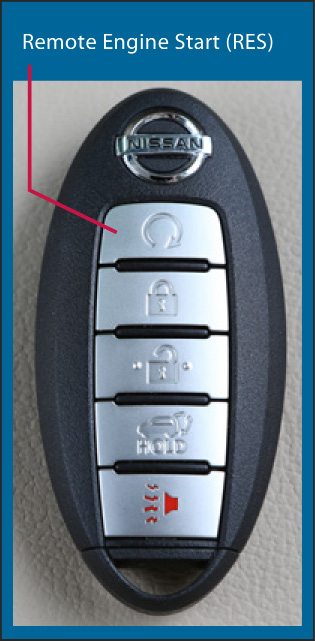
Extending Engine Run Time
The RES allows the engine to run for 10 minutes of normal use, and can be extended up to 20 minutes, "one time" with an extended time feature. Extending Run time is performed as follows:
- The first 10 minute run time will start when the remote start function is performed.
- With the doors still locked, a second 10 minutes can be added when the remote start function (RES) button is pressed again.
For example, if the engine has been running for 5 minutes, and 10 minutes are added, the engine will run for a total of 15 minutes. A maximum of two remote starts, or a single start with an extension, are allowed between ignition cycles.
Note: The ignition switch must be cycled to the ON position and then back to the OFF position before the remote start procedure can be used again
IMPORTANT NOTE
When programming intelligent keys for the 2013 Pathfinder, both I-Keys must be of the same type. Only program Remote Engine Start (RES) I-Keys to RES vehicles; do not attempt to program non-RES Intelligent Keys to vehicles with RES. If swapping of I-Key types is attempted issues with fob function will occur.
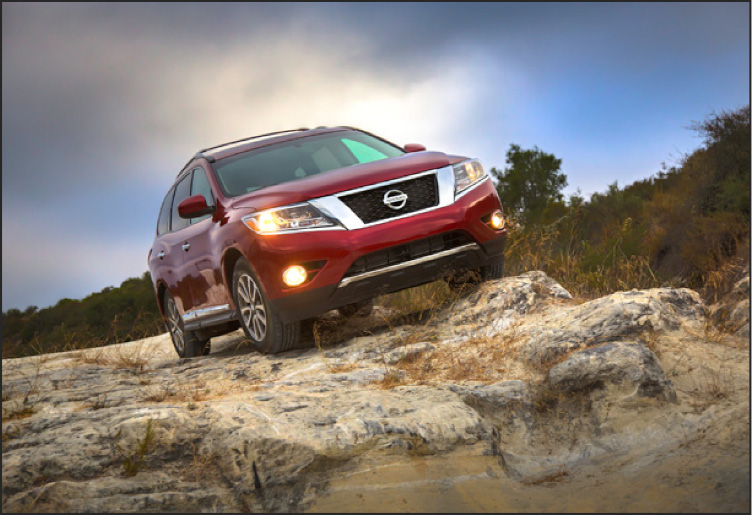
Inform your customers that laws in some local communities may restrict the use of remote starters. For example, some laws require a person using remote start to have the vehicle in view. Have them check local regulations for any requirements.
Around View™ Monitor
The Around View™ Monitor shows the driver a virtual 360-degree image of the area around the SUV. The system converts image data taken by 4 separate super-wide angle cameras. Image processing is used to show a virtual composite view. The monitor displays various views of the area around the vehicle, along with distance guides, vehicle width guides, and predictive course guides (if the steering wheel is turned). This helps the driver to visually confirm the vehicle's relation to the lines around the parking space. With this, the driver can position the vehicle for parallel parking and the predicted course to a parking space. The birds-eye view aids the driver by showing the surrounding view of the vehicle from above making it easier for the driver to position the vehicle. When you put the transmission in Reverse, two views appear on the center display screen. On the left is the camera view to the rear of the vehicle with guide markings that show the path the vehicle will follow. On the right is a composite view from above, showing the position of the vehicle.
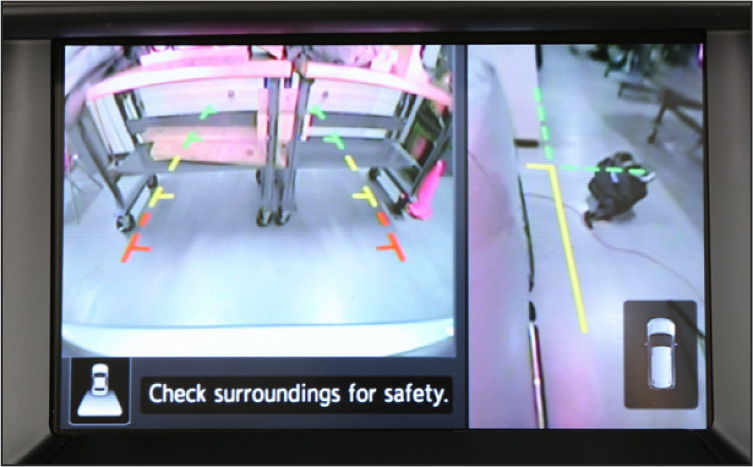
Note: Calibration must be performed after removing/replacing the cameras, removing parts (e.g. front grille, door mirror, etc.) that the cameras are mounted on, or replacing the Around View Monitor control unit. The use of CONSULT is required to perform calibration or writing of calibration re sults to the Around View Monitor control unit.
Tri-Zone Automatic Temperature Control system with microfilter
The Pathfinder comes equipped with a Tri-Zone Automatic Temperature Control system with microfilter. The design of this advanced climate control system provides full auto A/C for the front L/R and rear and helps keep the air inside of the vehicle clean.
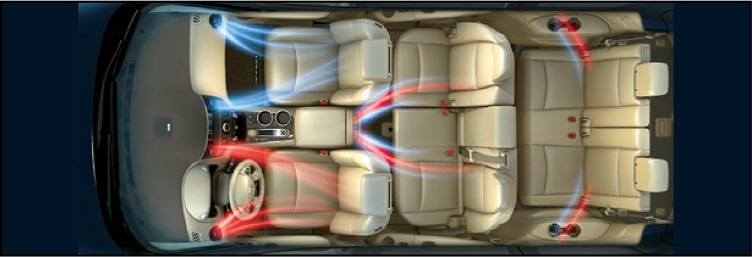
The driver and passenger can control their own separate climate settings with dual-zone controls.
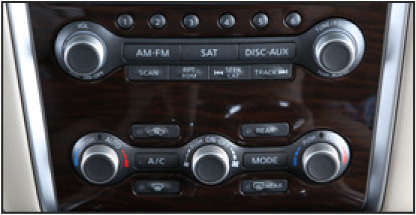
Passengers can adjust the rear automatic air conditioning system using the control switches at the rear of the center console to create another climate zone for the 2nd and 3rd-rows.
A positive temperature coefficient (PTC) heater is located in the back of the booster fan assembly. The PTC provides supplemental heat to the rear seating by warming the air as it flows through its electrically controlled heating grid.
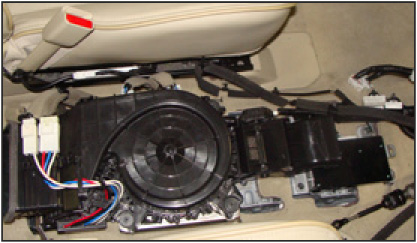
The rear blower motors function to vary the speed at which the air flows through the ventilation system. It also has an evaporator to provide cooling for rear passengers.
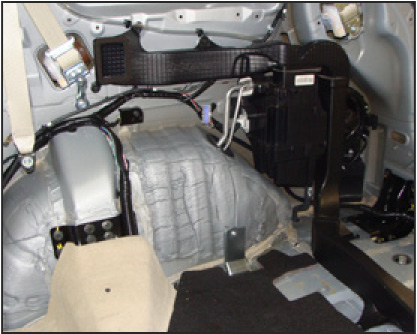
AUDIO AND ENTERTAINMENT
The Pathfinder comes with many standard audio features and can be equipped with optional premium level Bose® audio systems and entertainment upgrades. Its new technologies and services were designed to make the customer's driving experience a bit more comfortable, easier to control and efficient.
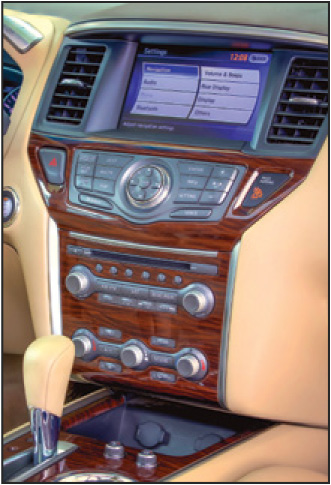
A dash mounted touch-screen monitor, mounted in the middle of the instrument panel, provides intuitive interaction and control of the available navigation system and other vehicle systems and settings. The screen displays the Nissan Hard Drive Navigation system with 8-inch VGA color touch-screen display, real-time traffic and weather info as well as Zagat Survey restaurant guide, Bluetooth Streaming Audio and RearView Monitor.
Audio System Technology
The Pathfinder comes standard with a six-speaker audio system with AM/FM/CD with MP3 playback capability, Radio Data System (RDS) and speed-sensitive volume control. The newly developed 6x9 speakers in the front door were designed specifically for low-frequency playback.
Note: The Nissan Pathfinder is equipped with state-of-the-art electronic circuits to enhance radio reception. These circuits are designed to extend reception range, and to enhance the quality of that reception.
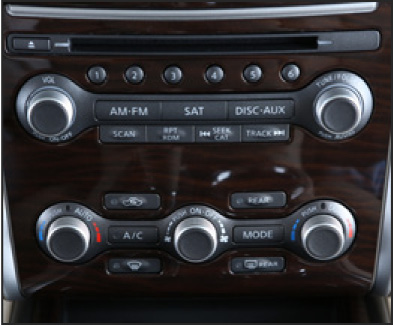
The Pathfinder can be equipped with an optional Bose® Cabin Surround® sound system with 13 speakers featuring Acoustic Waveguide subwoofer bass technology that provides digital 5.1 channel program decoding. The system layou t of seven speakers from the front door forward provides accurate and precise staging and imaging for the first-row passengers. The new 6x9" speakers comb ined with the new Bose subwoofer gives the system best-in-class, low-frequenc y performance. This layout, along with the addition of a rear-door tweeter, im proves the staging imaging for second- and third-row passengers.
Bose Acoustic Waveguide Subwoofer
The Bose subwoofer utilizes Bose's famous "waveguide" technology to increase the output of the subwoofer (subwoofer internal volume is 8.5L). This allows for big sound from a small space and leaves most of the trunk space for storage.
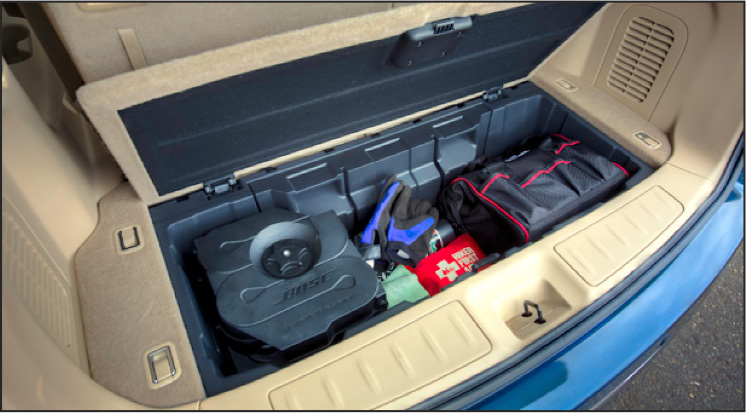
Bluetooth for hands-free phone
Nissan Pathfinder is equipped with a Bluetooth® Hands-Free Phone System. A compatible Bluetooth® enabled cellular phone can be connected with the in-vehicle phone module. With Bluetooth® wireless technology, calls can be made or received with the hands-free telephone system as long as the cellular phone is in the vehicle.
Once the cellular phone is connected to the in-vehicle phone mo dule, no other phone connecting procedure is required. The phone is automatically connected with the in-vehicle phone module when the ignition switch is placed in the ON position with the connected cellular phone turned on and in the vehicle.
Up to five different Bluetooth® cellular phones can be paired to the in-vehicle phone module. However, only one cellular phone can be connected to the Bluetooth® hands-free at one time.
NISSAN Voice Recognition system is supported with the phone commands, so dialing a phone number using voice recognition is possible.
IPod integration
There's a USB connection port for iPod® interface and other compatible devices. To connect an iPod® to the vehicle so that the iPod® can be controlled with the audio system controls and display screen, the customer must use the USB jack located in the center console.
Note: While connected to the vehicle, the iPod® can only be operated by the vehicle's audio controls.
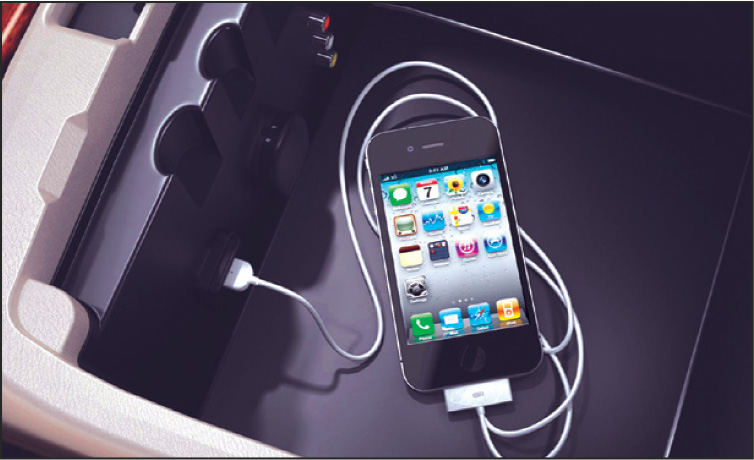
NTSC/PAL compatible devices such as video games, camcorders and portable video players can be connected to the system through the auxiliary input jacks located in the center console. Compatible storage devices can be connected to the system through the USB input jack. Compatible audio files on the storage device can be played through the vehicle's audio system. When a compatible portable storage device is plugged into the USB jack located in the center console, compatible image files stored on the device can be viewed on the control panel display. A list of compatible images on the storage device is displayed on the left side of the screen, while the selected image is displayed on the right side of the screen. The images can also be viewed as a slide show, and the time interval and order for the images can be changed.
Dual Head Restraint DVD System
The available head-restraint mounted DVD monitors provide rear seat occupants entertainment right at eye level. This system consists of adjustable 7" widescreen LCD monitors with backlit screens. These displays can be used simultaneously or independently of each other using the USB 2.0 or the audio/video inputs for auxiliary equipment.
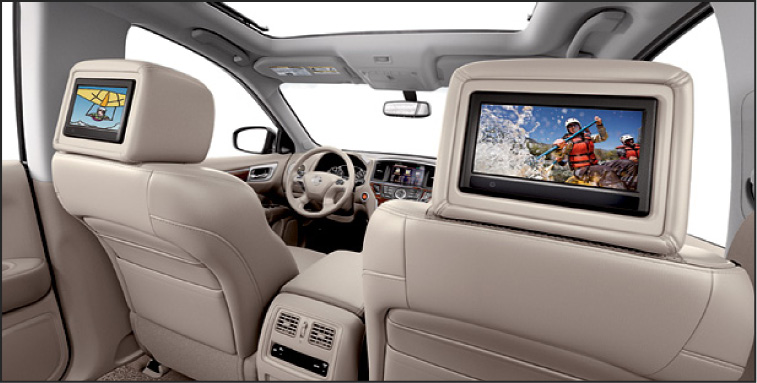
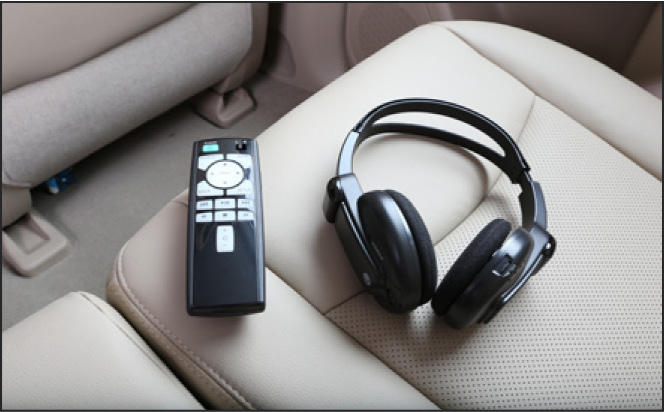
SAFETY
The Pathfinder's Advanced Airbag System (AABS) for driver and front passenger consists of seat belt sensors and occupant classification sensors. It's equipped with roof mounted curtain side-impact air bags for front-and-rear outboard, occupant head protection (includes rollover sensor). It also has driver and front passenger seat-mounted side-impact supplemental air bags.
Nissan Vehicle Immobilizer System and Vehicle Security System
The vehicle security system provides visual and audible alarm signals if someone opens the doors, liftgate or hood when the system is armed. It is not a motion-detection type system.
The Nissan Vehicle Immobilizer System will not allow the engine to start without the use of a registered Nissan Vehicle Immobilizer System key.
In some circumstances, interference from items on the key ring such as another I-Key, an automated toll road devise or payment device might prevent the engine from starting. If this occurs, start the engine using the following procedures:
1. Leave the ignition switch in the ON position for approximately five seconds.
2. Place the ignition switch in the OFF or LOCK position, and wait approximately 10 seconds.
3. Repeat steps 1 and 2.
Note: If the no-start condition recurs, suggest to customers that they place the registered Nissan Vehicle Immobilizer System key on a separate key ring to avoid interference from other devices.
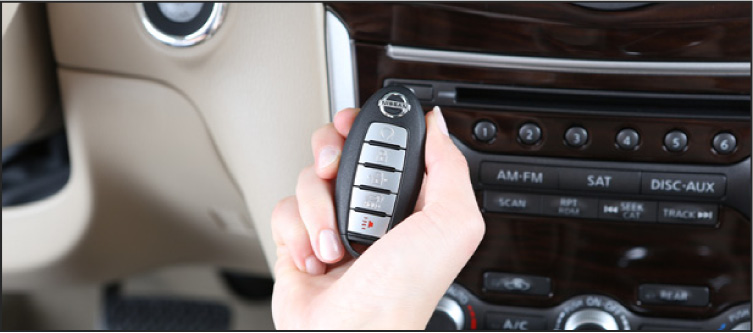
Anti-Lock Braking (ABS) with Electronic Brake Force Distribution (EBD)
The Pathfinder's advanced braking system automatically responds to changing conditions. ABS helps maintain control by working to prevent wheel lockup during emergency braking situations. If the rear area of the vehicle is weighted with passengers, cargo, or even just a full tank of gas, Electronic Brake force Distribution sends extra force to help the rear brakes to compensate. ABS and EBD are standard features.
Vehicle Dynamic Control (VDC) and Traction Control System (TCS)
The Vehicle Dynamic Control (VDC) system is a standard feature that is sometimes referred to as stability control. It uses various sensors to continuously monitor driver inputs and vehicle motion. It senses oversteer and understeer and compensates by reducing engine speed and/or controlling brake pressure to specific wheels. The traction control system can sense drive wheel slip or spin and responds by helping to reduce throttle to help maintain traction.
4-wheel ventilated disc brakes
The new Pathfinder is equipped with power-assisted disc brakes a t all four corners, measuring 12.6 inches on the front vented discs and 12.13 inches vented discs on the rear.
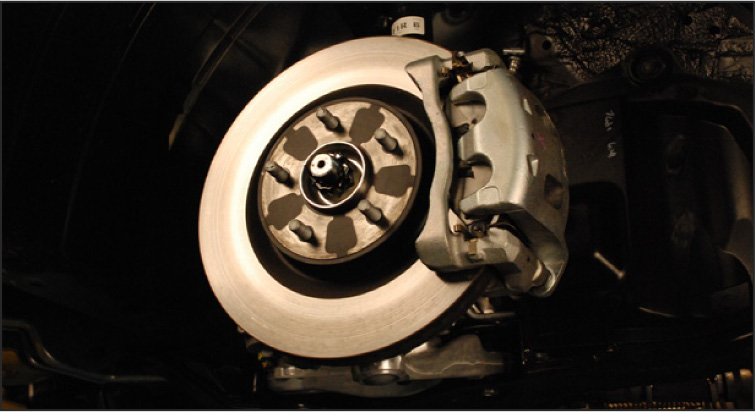
Tire Pressure Monitoring System (TPMS) (with warning lamp in meter cluster)
The new Pathfinder has been equipped with a Tire Pressure Monitoring System (TPMS) that illuminates a low tire pressure telltale when one or more of the tires are significantly under-inflated. The tire pressure of all tires (except the spare) will display on the vehicle information display screen (if so equipped). The TPMS will activate only when the vehicle is driven at speeds above 16 MPH (25 km/h).
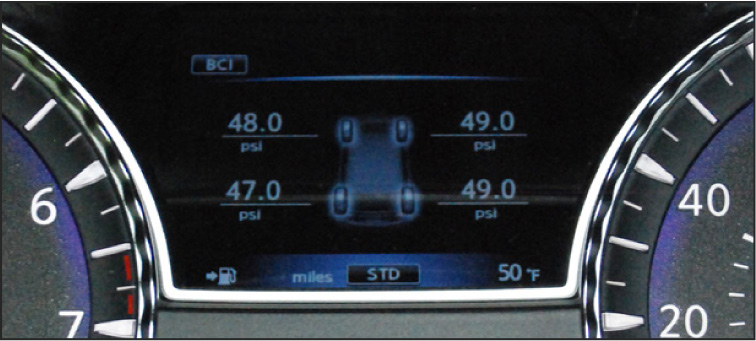
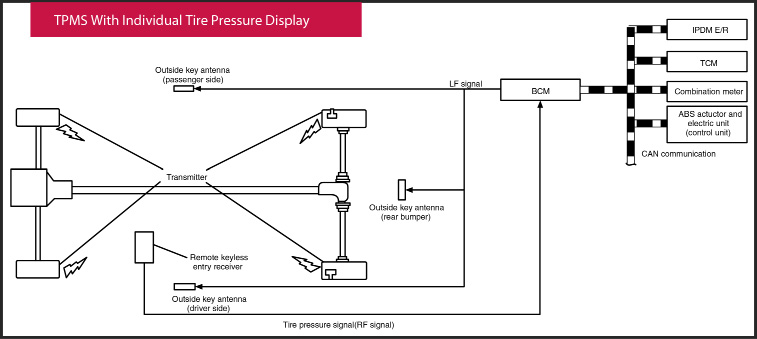
TPMS with Easy-Fill Tire Alert
When adding air to an under-inflated tire, the TPMS with Easy-Fill Tire Alert provides visual and audible signals outside the vehicle to help the customer inflate the tires to the recommended COLD tire pressure. When adding air to the tire after a few seconds, the hazard indicators start flashing. When the tire reaches the correct pressure, the Easy-Fill Tire alert will sound the horn once and stop the hazard indicators from flashing to indicate the pressure is correct. If the tire is over-inflated more than approximately 4 psi (30 kPa), the horn beeps and the hazard light indicators flash 3 times. If the Easy-Fill Tire Alert does not operate due to TPMS interference, move the vehicle about 3 ft (1 m) backward or forward and try again.
The tire pressure sensors generate a radio frequency (RF) signal to the Remote keyless entry receiver. The I-Key antennas generate a low frequency signal. The BCM uses the triangulated antenna signal to identify the location of each sensor.
The BCM receives a signal transmitted from the tire pressure sensors/transmitters installed in each wheel. If the BCM detects low inflation pressure or a system malfunction, it sends a signal to the combination meter via CAN communication.
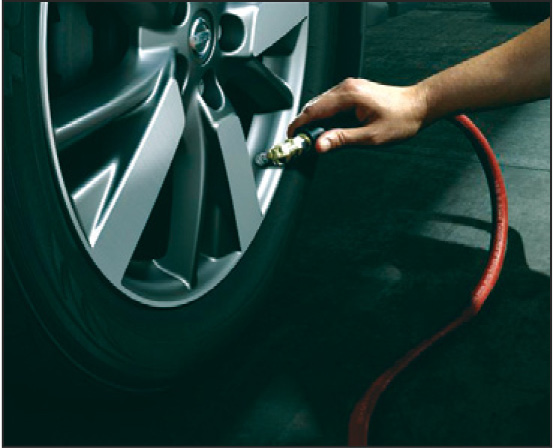
Power Rear Liftgate
The power liftgate can automatically move from the fully closed position to the fully open position in approximately five to eight seconds. The hazard lights flash and a chime will sound to indicate the power open sequence has been started.
- The liftgate can be opened by the instrument panel switch, liftgate request switch, and the keyfob even if the vehicle is locked. Once the liftgate is closed, its lock will align to the vehicle's lock or unlock status.
- The keyfob button must be held for approximately 0.5 seconds before the liftgate opens.
- The liftgate must be unlocked to open it with the liftgate opener switch.
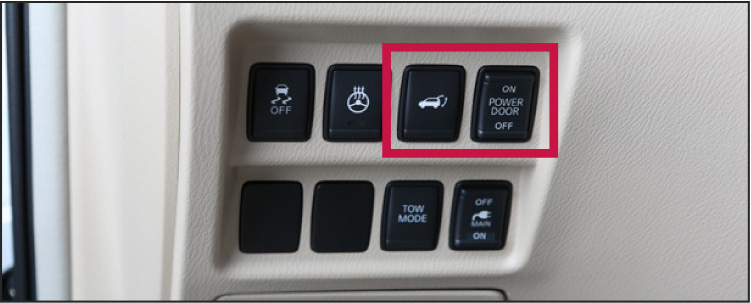
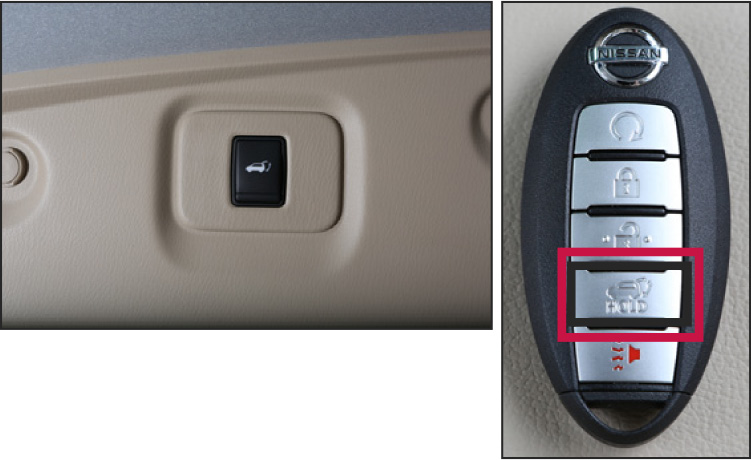
Auto Reverse
If an obstacle is detected during power open or power close, a warning chime will sound and the liftgate will reverse direction and return to the full open or full close position. If a second obstacle is detected, the liftgate motion will stop and the drive motor will disengage. The liftgate will enter manual mode.
A pinch strip is mounted on each side of the liftgate. If an obstacle is detected by a pinch strip during power close, the liftgate will reverse direction and return to the full open position.
Note: If the pinch strip is damaged or removed, the power close function will not operate.
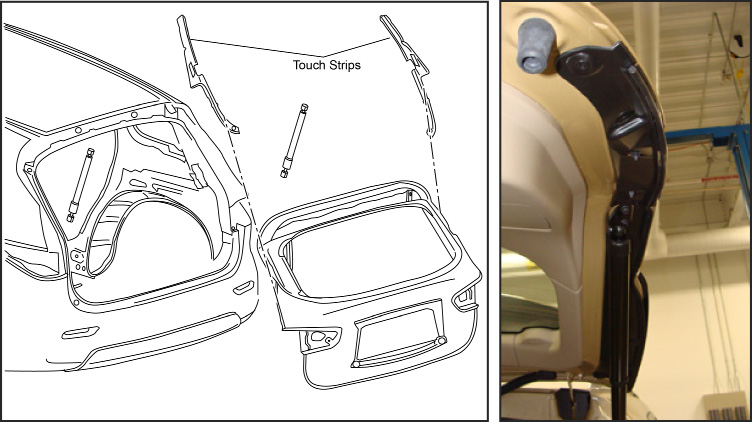
Manual Mode
If power operation is not available, the liftgate may still be operated manually. The following may cause power operation to not be available even if the power liftgate main switch is in the ON position: if multiple obstacles have been detected in a single power cycle, or if battery voltage is too low.
To open the liftgate manually, press the liftgate opener switch and lift the liftgate.
To close, lower and push the liftgate down securely.
Safe Mode
If the liftgate spindle units lose pressure, the power liftgate safe mode is activated. When the safe mode is activated, the liftgate slowly closes. A continuous warning chime sounds until the liftgate is in the fully down position. Then the liftgate will be pulled to the closed and latched position by the cinching motor. The power liftgate cannot be opened using the switches while the power liftgate is in safe mode. The auto reverse function remains active while the liftgate is closing in the power liftgate safe mode.
Power Liftgate Release
If the liftgate cannot be opened with the instrument panel switch, liftgate opener switch or keyfob due to a discharged vehicle battery, follow these steps:
1. Remove the finisher cover on the inside of the liftgate.
2. Move the lever as indicated to open the lift gate.
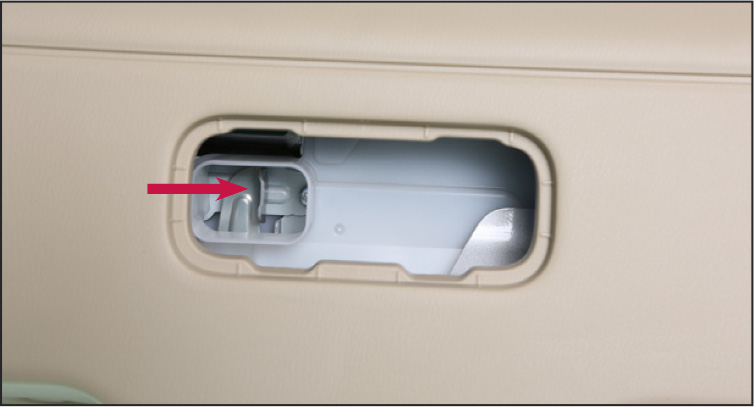
Garage Mode
Garage mode is a convenient feature for people who routinely pa rk in a garage with a low ceiling, or who have difficulty reaching high enough to grasp the liftgate when it's fully open. This feature allows setting the liftgate to open only to a user-selected height.
Use the liftgate opener switch on the outside of the liftgate to open or stop the liftgate.
Use the liftgate switch on the bottom of the liftgate to set a new opening height.
To activate this function:
- Park the vehicle in a location where the liftgate can open to its highest point. Make sure the liftgate is closed and the shift lever is in Park (P).
- Make sure the power liftgate main switch on the instrument panel is in the ON position, and then press the liftgate opener switch on the outside of the liftgate and let the liftgate open fully.
- Manually move the liftgate to the height where you want it to stop. Then, push and hold the switch on the lower part of the liftgate until you hear three beeps (approximately five seconds).
The liftgate will now be set to only to the height selected. To reset the height, simply position the liftgate to the new height, and then press and hol d the liftgate switch on the lower portion liftgate auntil you hear three beeps (approximately five seconds).
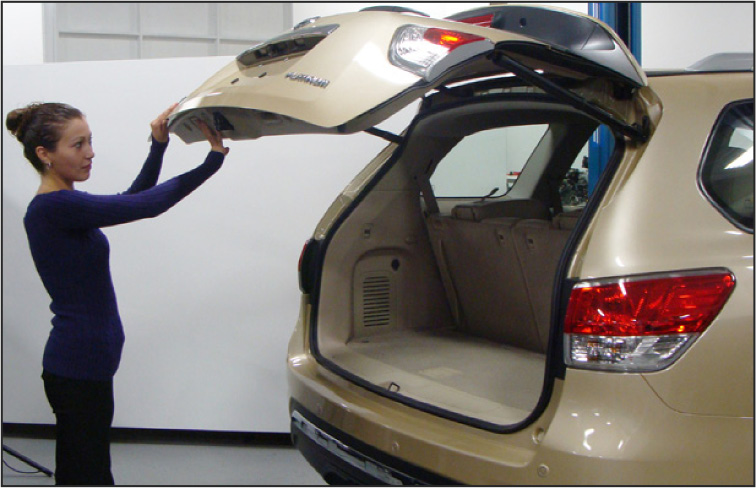
Maintenance Tips
Continuously Variable Transmission
Note: The 2013 Pathfinder CVT requires Genuine Nissan CVT NS-3 Fluid.
Electric Hydraulic Power Steering
The Pathfinder is equipped with an electric hydraulic power steering system; the engine does not require a power steering pump pulley. This allows for a simplified belt layout and serviceability.
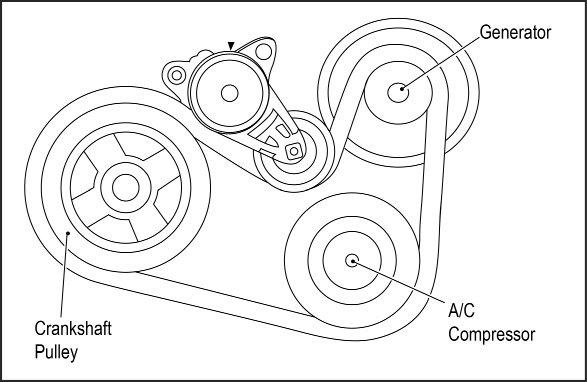
HEPS Air Bleeding Procedure
To bleed the air from the system, follow these steps:
1. With the engine OFF, inspect the fluid level for the HEPS system and, if necessary, add fluid.
2. Turn the steering wheel from the full right stop to the full left stop position several times. Repeat as necessary until bubbles no longer appear in the reservoir.
Note: Raise the vehicle off the ground when turning the steerin g wheel with the engine OFF.
3. Inspect the fluid level again and, if necessary, add fluid.
4. Repeat step 2 several times until the power steering fluid stabilizes.
5. Start the engine and allow it to idle.
6. With the engine ON, turn the steering wheel from the full right stop to the full left stop position several times. Repeat as necessary until bubbles no longer appear in the reservoir.
7. Inspect the fluid level again and, if necessary, add fluid.
8. Turn OFF the engine.
9. Inspect the fluid level again. The level should be between the hatching area on the indicator on the power steering reservoir tank cap.
Note: Use of a power steering fluid other than Genuine NISSAN E-PSF will prevent the power steering system from operating properly.
Extended Storage Switch (ESS) and BCM transit mode
The Extended Storage Switch (ESS) and BCM transit mode are enabled/disabled together with the fuse switch as one operation as opposed to separately as on other models. This configuration is referred to as Shipping Mode. The ESS must be set to the "Customer Delivery" position before the vehicle is delivered to the customer.
Note: If this feature is not disabled (fuse pushed in) it will lead to various system INOP symptoms and a warning message displayed on the Information display in the combination meter.
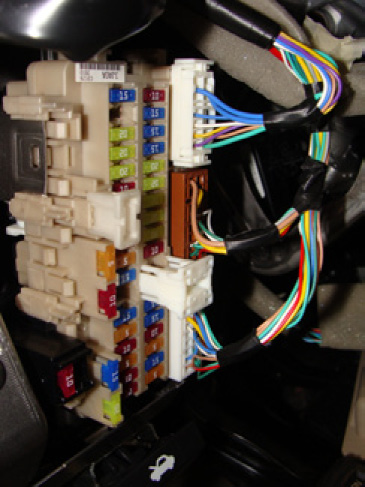
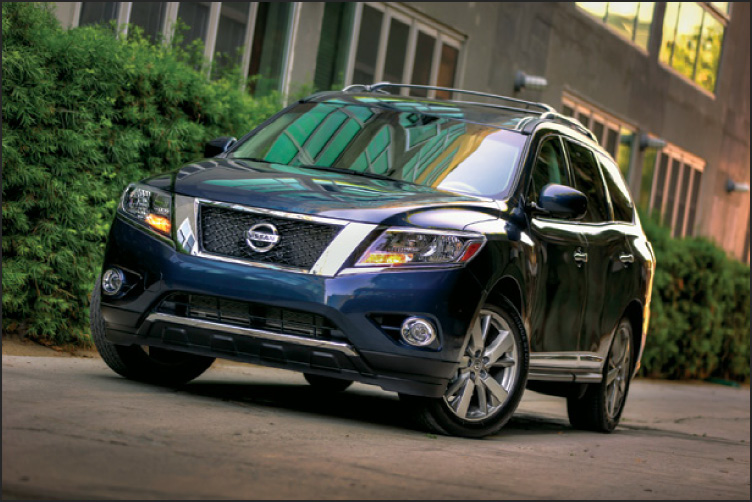
Special Tools
Transmitter Wake-Up Operation
New replacement transmitters are provided "asleep" and must first be "woken up" using Transmitter Activation Tool J-45295-A or Signal Tech II T ool J-50190 before ID registration can be performed. This procedure must also be done after replacement of a TPMS transmitter or BCM.
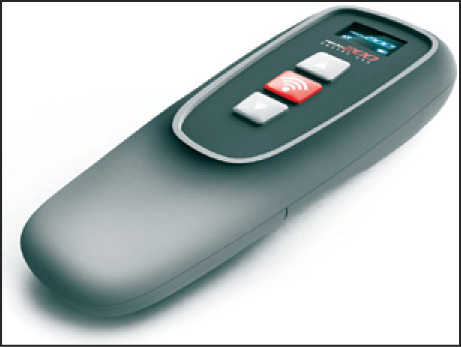
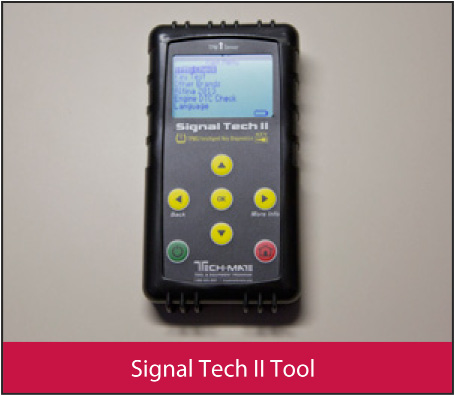
Service Training
Pathfinder New Model
Service Training is offering a two-day hands-on course features both the Pathfinder and Sentra. Technicians will first discover features and technologies on each of these new models. The 2013 Pathfinder new model training consists of:
- Engine and CVT overview
- 4X4-i All Wheel Drive system components and service
- Tri-Zone Automatic Temperature Control system operation
- Power Back Door adjustment and controls
- Family Entertainment System functions and diagnosis
- Advanced Drive Assist Display (ADAD) function and settings
- Around View Monitor Self Diagnosis and Work Support CONSULT functions
- Remote Engine Start system (RES) troubleshooting